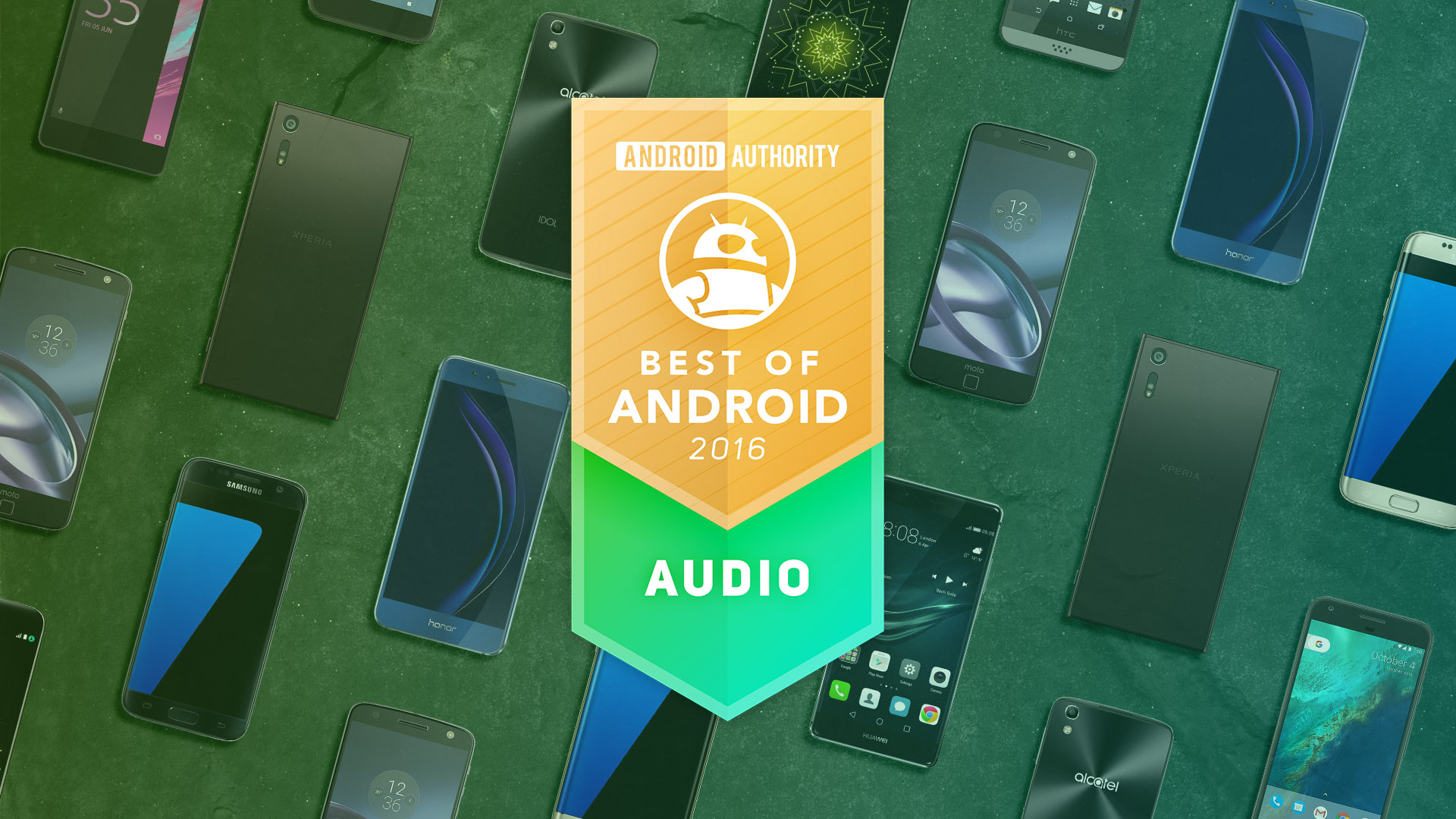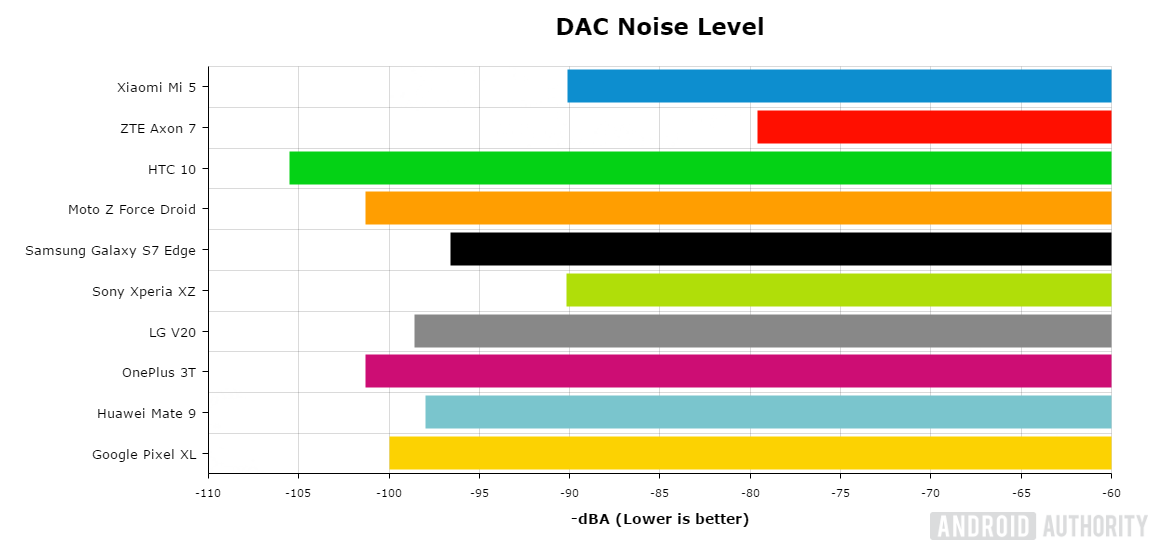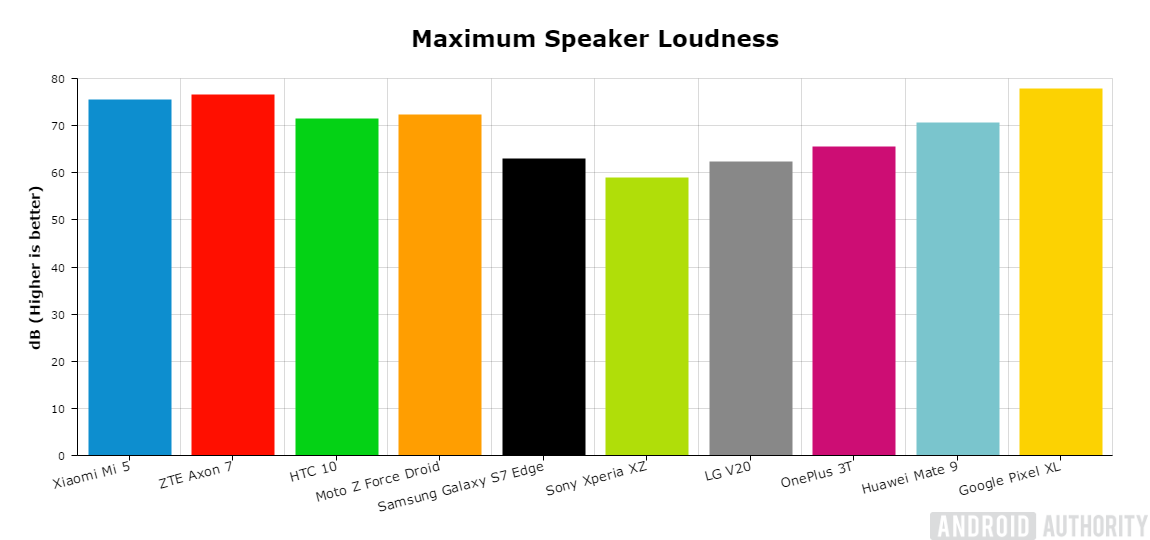Affiliate links on Android Authority may earn us a commission. Learn more.
Best of Android 2016 - Audio

What is Best of Android?
In Best of Android, we take the most important smartphones of the year and compare them side-by-side and in-depth. This year, with so many good phones available, we've stepped things up a notch and brought the 10 biggest Android phones of the year to the competition.
- Samsung Galaxy S7 Edge
- HTC 10
- Sony Xperia XZ
- Google Pixel XL
- Xiaomi Mi 5
- Lenovo Moto Z Force Droid
- OnePlus 3T
- LG V20
- HUAWEI Mate 9
- ZTE Axon 7
Read more about Best of Android and thanks for being such a valuable part of the Android Authority family!
Up next in our Best of Android 2016 series is some audio testing. We’ve seen manufacturers increasingly boast about the HiFi playback capabilities of their smartphones this year, and better quality audio components. So let’s see if the hardware has what it takes.
DAC Signal to Noise
If you’re looking for a smartphone capable of playing back audiophile grade files, then you’ll definitely want to take a look at the signal to noise ratio of the handset’s DAC. There’s a very important relationship between noise and audio file bit-depth. The bit-depth tells us the level of the quantization error when rounding values to their nearest digital value. A 24-bit file offers a maximum signal-to-noise ratio of -144dB, compared with -96.3dB for a 16-bit file. Although there’s more to this discussion that we’ll have to save for another time.
Regardless, if you want to maximize the available quality of these files, then we need a physical DAC and amplifier output stage that is just as noiseless as the audio files. There’s no point in listening to a 24-bit file through a system with a 50dB SNR. A higher SNR also means that quality should be retained better as we turn the volume down, as there additional headroom before we hit the noise floor, and gives us an idea about how clean the audio signal path is inside the smartphone. We certainly don’t want to be picking up noise from processors or charge pump circuits.

The clear leader this year, and by some margin, is the HTC10, with an impressive -105.5dB. This result begins to push up against the limits of our testing equipment and offers plenty of headroom for detailed listening at lower playback volumes. Other notable entries include the OnePlus 3T, Google Pixel XL, and the Moto Z Force Droid, which all pull in at just under -100dB, but any benefits from 24-bit files will be impossible to distinguish without the volume cranked all the way up. The HUAWEI Mate 9 and LG V20 are also quite good and come in at just above CD quality SNR, and should still provide a good representation at lower listening levels. The Xiaomi M5 and Sony Xperia XZ will be disappointing from an audiophile perspective and certainly don’t appear to be worth wasting time playing back 24-bit files on. Although a score around -90dB is still good enough for reasonable sounding playback, it just won’t satisfy those looking for the highest quality option.
The ZTE Axon 7 is a clear anomaly in our testing, and a SNR of just -79.6dB is rather poor and well behind the competition. We re-ran the test multiple times and repeatedly saw similar results, so we either have a bit of a dud handset or there’s something really wrong with the way that the audio signal path has been laid out on the motherboard.
All of that being said, there’s more to a good sounding representation above and beyond just SNR, and it’s unlikely that casual listeners will be disappointing in the sound available from any of these handsets. To help build up a bigger picture, we’ve also tested the voltage output of the headphone amplifiers. This gives us an idea about how much power we’re able to obtain from each amplifier, but this will vary considerably based on the headphones that you have connected, so it’s more of a rough guide.
Voltage
| OnePlus 3T | .829 | Google Pixel XL | .99 |
| HUAWEI Mate 9 | .347 | Samsung Galaxy S7 Edge | .76 |
| Sony Xperia XZ | .382 | LG V20 | 1.009 |
| ZTE Axon 7 | 1.21 | Xiaomi Mi 5 | .18 |
| Lenovo Moto Z Force Droid | 1.45 | HTC 10 | 1 |
Based on this data, the Moto Z Force Droid is a standout performer for output power, followed very closely by the ZTE Axon 7. The LG V20, HTC10, and Google Pixel XL all offer up virtual identical output voltages too, and shouldn’t have too much trouble driving even the lowest impedance headphones with adequate volume.
The Sony Xperia XZ, HUAWEI Mate 9 and Xiaomi Mi 5 seem to offer considerably lower output voltages and may struggle to offer up as much volume as other headsets, and there’s a greater risk of small signals coming closer to the noise floor. That being said, current is an equally important factor when it comes to headphone power.
Speaker Volume
As well as headphone playback, we’ve also testing the loudness of each handset’s speaker to give you a feel for the maximum volume you can achieve while playing back videos and music to friends and family. The test is simple, we stood back exactly 1 meter from the handset’s speaker with our decibel meter and took some measurements.

The top three loudest speakers comprise of the Google Pixel XL at 77.8dB, followed by the ZTE Axon 7 on 76.6dB, and the Xiaomi Mi 5 at 75.6dB. All three of these will provide plenty of volume for playback, even is busy environments. The top three are followed closely by the HTC10, Moto Z Force Droid, and the HUAWEI Mate 9, all of which will still provide plenty of volume for most playback scenarios.
At less than 70dB, the OnePlus 3T, LG V20, and Samsung Galaxy S7 edge are notable quieter than our leading handsets. Although it’s the Xperia XZ that is notably the worst for playback volume. Remember that decibels are a logarithmic scale, and a 10dB increase doubles the perceived loudness. So the Xperia XZ at just 58.9dB will sound only a quarter as loud as the Pixel XL at this typical listening distance. Or you could view this as the Pixel XL being able to put out four times the volume as the Xperia XZ.
Conclusion
For headphone playback, the HTC10 edges out in front, followed closely by the Moto Z Force Droid, Google Pixel, and OnePlus 3T. HTC’s entry also offers up one of the louder speakers out of the handsets in our test group, making it the best all-rounder. However, it’s the ZTE Axon 7 and Google Pixel which offer the loudest presentation when playing back content through the speakers.
Audio enthusiasts have plenty of good options to chose from from this year’s Android flagships, but it’s the HTC10 and Google Pixel that top our testing. The Xperia XZ is probably a handset to avoid if audio is going to be your primary use.
Thanks for reading and be sure to check out the other categories in the Best of Android 2016 series.
Credits
Tested by: Gary Sims, Andrew Grush, Nirave Gondhia, John Velasco, Joshua Vergara, Lanh Nguyen
Series Contributors: Rob Triggs, Edgar Cervantes, Kris Carlon
Series Editors: Nirave Gondhia, Bogdan Petrovan, Andrew Grush